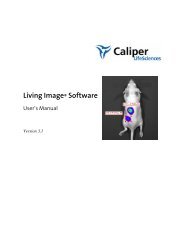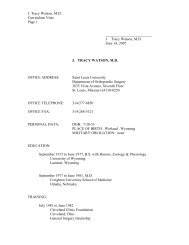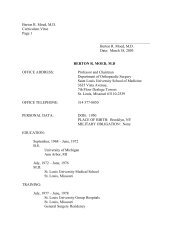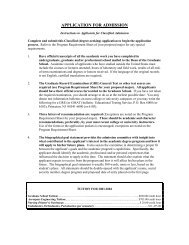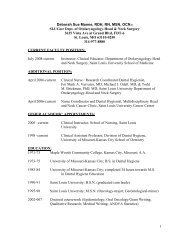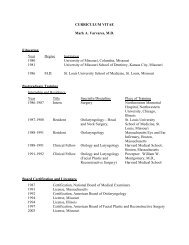Implantable infusion pumps for chronic rodent studies
Implantable infusion pumps for chronic rodent studies
Implantable infusion pumps for chronic rodent studies
You also want an ePaper? Increase the reach of your titles
YUMPU automatically turns print PDFs into web optimized ePapers that Google loves.
<strong>Implantable</strong> <strong>infusion</strong> <strong>pumps</strong> <strong>for</strong><br />
<strong>chronic</strong> <strong>rodent</strong> <strong>studies</strong><br />
Presenter: John W. Osborn, Ph.D.<br />
University of Minnesota<br />
Department of Integrative Biology and Physiology<br />
Discussant: Gregory D. Fink, Ph.D.<br />
Michigan State University<br />
Department of Pharmacology and Toxicology
Scientific Application<br />
• Chronic administration of pharmacological<br />
agents to non-tethered <strong>rodent</strong>s.<br />
• Routes of administration:<br />
– Subcutaneous<br />
– Intraperitoneal<br />
– Intravenous<br />
– Intracerebroventricular<br />
• Duration of <strong>studies</strong>: days to weeks
Current available options<br />
• Alzet osmotic mini<strong>pumps</strong> (www.Alzet.com)<br />
– Rats and mice<br />
– Relatively inexpensive<br />
– Variable reproducibility<br />
• iPrecio (www.iPrecio.com)<br />
– Rats and larger species<br />
– Relatively expensive<br />
– Programmable and refillable in vivo<br />
– Precise and reproducible
Outline<br />
• Alzet <strong>pumps</strong><br />
– Pump design and models available<br />
– Filling and implanting <strong>pumps</strong><br />
• iPrecio <strong>pumps</strong><br />
– Pump design<br />
– Filling and programming the pump<br />
– Implanting <strong>pumps</strong><br />
• Cost comparison<br />
• Real world experiences with both <strong>pumps</strong><br />
• Summary: Pros and cons
Alzet :Design and models<br />
Design Concept<br />
Osmotic movement of<br />
body fluids into the<br />
“osmotic layer”<br />
compresses internal<br />
reservoir which<br />
displaces infusate into<br />
the catheter.<br />
100 l<br />
200 l<br />
2 mL<br />
Fixed Infusion Rates: 0.11 to 10 ul/hr<br />
Durations: 1 day to 6 weeks
Alzet applications<br />
• Implantation site<br />
– Subcutaneous<br />
– Intraperitoneal<br />
• Routes of administration<br />
– Subcutaneous<br />
– Intraperitoneal<br />
– Intravenous<br />
– Intracerebroventricular<br />
– Fat pads
Alzet: Filling the pump<br />
ALWAYS USE GLOVES! The natural oils from your hands<br />
will damage the exterior of the pump casings.<br />
Weigh the empty pump (body + flow regulator) and<br />
record weight<br />
Use needle supplied with <strong>pumps</strong> to draw infusate into<br />
syringe.<br />
Be sure all air bubbles are removed from the syringe.<br />
USE CARE when inserting filling needle/syringe into<br />
pump body so you don’t puncture the bladder.<br />
Fill the pump slowly and retract needle as it fills.<br />
Stop filling when a bead of infusate rises out of the<br />
pump.
Alzet: Filling the pump<br />
Withdraw needle and insert flow<br />
regulator into pump.<br />
Reweigh the pump and record. Increase in<br />
weight should equal the filling volume<br />
Keep pump upright until it is implanted.<br />
You may or may not choose to prime the<br />
pump be<strong>for</strong>e implantation.
Alzet: Implanting the pump<br />
Use sterile technique!<br />
Subcutaneous implantation<br />
Intraperitoneal implantation
iPRECIO<br />
900 ul reservoir<br />
Port <strong>for</strong> refilling<br />
Roller pins<br />
Catheter<br />
Design Concept<br />
Roller peristaltic pump that transfers infusate<br />
from reservoir to the catheter.<br />
6 month battery life<br />
(@ 0.1 ul/hr flow rate).
iPRECIO is programmable<br />
Infusion modes: Instant or post recovery (delayed)<br />
Flow rate modes: Constant or variable from 1 to 30 ul/hr in 0.1 ul/hr steps<br />
(up to 10 different rates)
iPRECIO<br />
Refillable design<br />
• Refill by insertion of needle through the skin.<br />
• Long duration of <strong>infusion</strong> periods.<br />
• Ability to change infusates at any time during the protocol (e.g.,<br />
“washout period).
Alzet<br />
Model 1002: $28/pump<br />
Model 2004: $28/pump<br />
Model 2ML2: $33/pump<br />
What does it cost?<br />
iPRECIO<br />
1) Software/management system-$1700.00<br />
2) Pump cost = $1250.00/5 <strong>pumps</strong><br />
= $250/pump<br />
Note: sold as a “single use” pump but it is<br />
possible to resterilize and reuse.
Real world experiences<br />
with both Alzet and<br />
iPRECIO implantable<br />
<strong>pumps</strong>
Sympathetic signature of AngII-salt<br />
hypertension in the rat<br />
Osborn, Kuroki and Fink<br />
Current Hypertension Reports, 2011
AngII-salt hypertension in the rat<br />
High NaCl diet: 2.0%<br />
Normal NaCl diet: 0.4%<br />
Low NaCl diet: 0.1%<br />
2ML2 model<br />
Most measurements made continuously over entire experimental protocol<br />
• Arterial pressure and heart rate (telemetry)<br />
• Sympathetic nerve activity (hardwired and telemetry)<br />
• Whole body and regional norepinephrine spillover
The “classic” AngII-salt response<br />
Osborn and Fink. Exp Physiol. 95(1): 61-68, 2010.<br />
Neurogenically<br />
Mediated
Recent unresolved issue with Alzet <strong>pumps</strong>:<br />
Failure to maintain the hypertension<br />
Same protocol and dose<br />
of AngII<br />
Questions<br />
Poor reproducibility in<br />
pump rates?<br />
Degradation of AngII in<br />
the pump?<br />
Why is this a new<br />
problem?
Variable <strong>infusion</strong> rates do not explain the<br />
4.3 L/hr<br />
variable pressure responses<br />
3.6 L/hr<br />
Theoretically the 2ML2 model:<br />
• <strong>pumps</strong> at 5 L/hr which is…<br />
• 0.12 mL/24h which is…<br />
• 1.68 mL over 14 days<br />
• Residual volume = 0.32 mL<br />
The rate is slower than<br />
predicted and quite<br />
variable
Use of 5% albumin vehicle <strong>for</strong> delivery of peptides<br />
Many proteins adsorb nonspecifically to plastic<br />
materials. ALZET <strong>pumps</strong> are manufactured from<br />
elastomers selected to minimize adsorption.<br />
However, if adsorption is a concern, DURECT<br />
recommends addition of 1-5% protease-free<br />
serum albumin to the vehicle <strong>for</strong> <strong>infusion</strong>.
Addition of BSA to infusate improves the<br />
“slow pressor AngII model” in the mouse<br />
(Davisson Lab, Cornell)
Addition of BSA to infusate has no effect in the<br />
“AngII-salt model” in the rat<br />
MAP (mmHg)<br />
150<br />
140<br />
130<br />
120<br />
110<br />
100<br />
90<br />
(Osborn Lab)<br />
80<br />
0 2 4 6 8 10 12 14 16 18 20<br />
DAYS<br />
Saline n=3<br />
BSA n=3
Big <strong>pumps</strong> and small <strong>pumps</strong> are not the same<br />
MAP (mmHg)<br />
150<br />
140<br />
130<br />
120<br />
110<br />
100<br />
90<br />
80 0 2 4 6 8 10 12 14 16 18 20<br />
DAYS<br />
2ML2 n=3<br />
2004 n=6
MAP (mmHg)<br />
160<br />
140<br />
120<br />
100<br />
80<br />
Comparison of iPRECIO and Alzet<br />
Alzet n=3<br />
iPrecio n=3<br />
Insert Alzet and<br />
iPrecio <strong>pumps</strong><br />
0 200 400 600 800<br />
Hours<br />
Filled iPrecio <strong>pumps</strong><br />
with Saline<br />
Removed Alzet<br />
Pumps
Alzet<br />
iPRECIO<br />
Summary<br />
Pros Cons<br />
Mice and rats Variability<br />
Low cost Issues with peptides?<br />
Easy to use<br />
Programmable Cost<br />
High precision<br />
Up to 6 month <strong>infusion</strong>s




